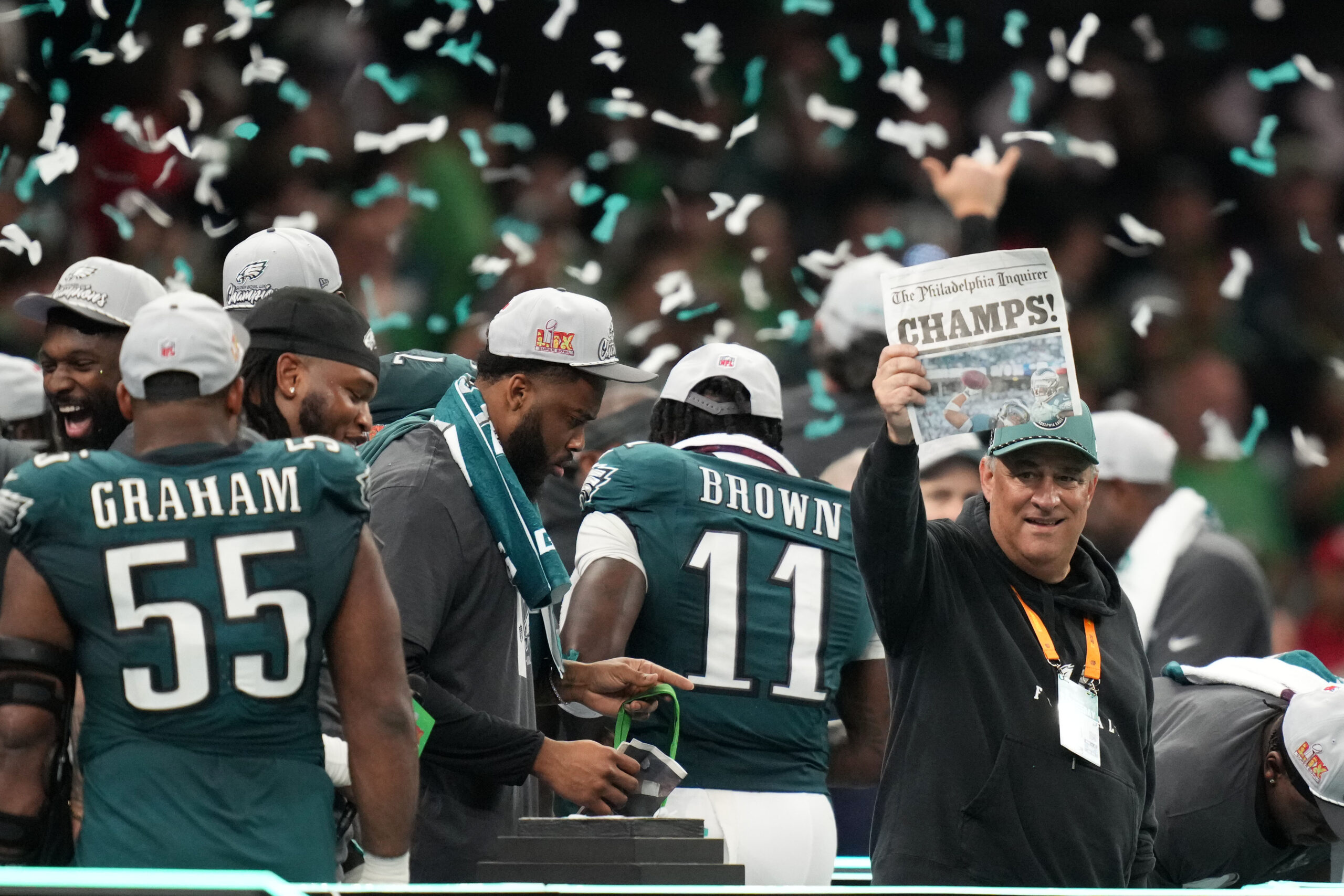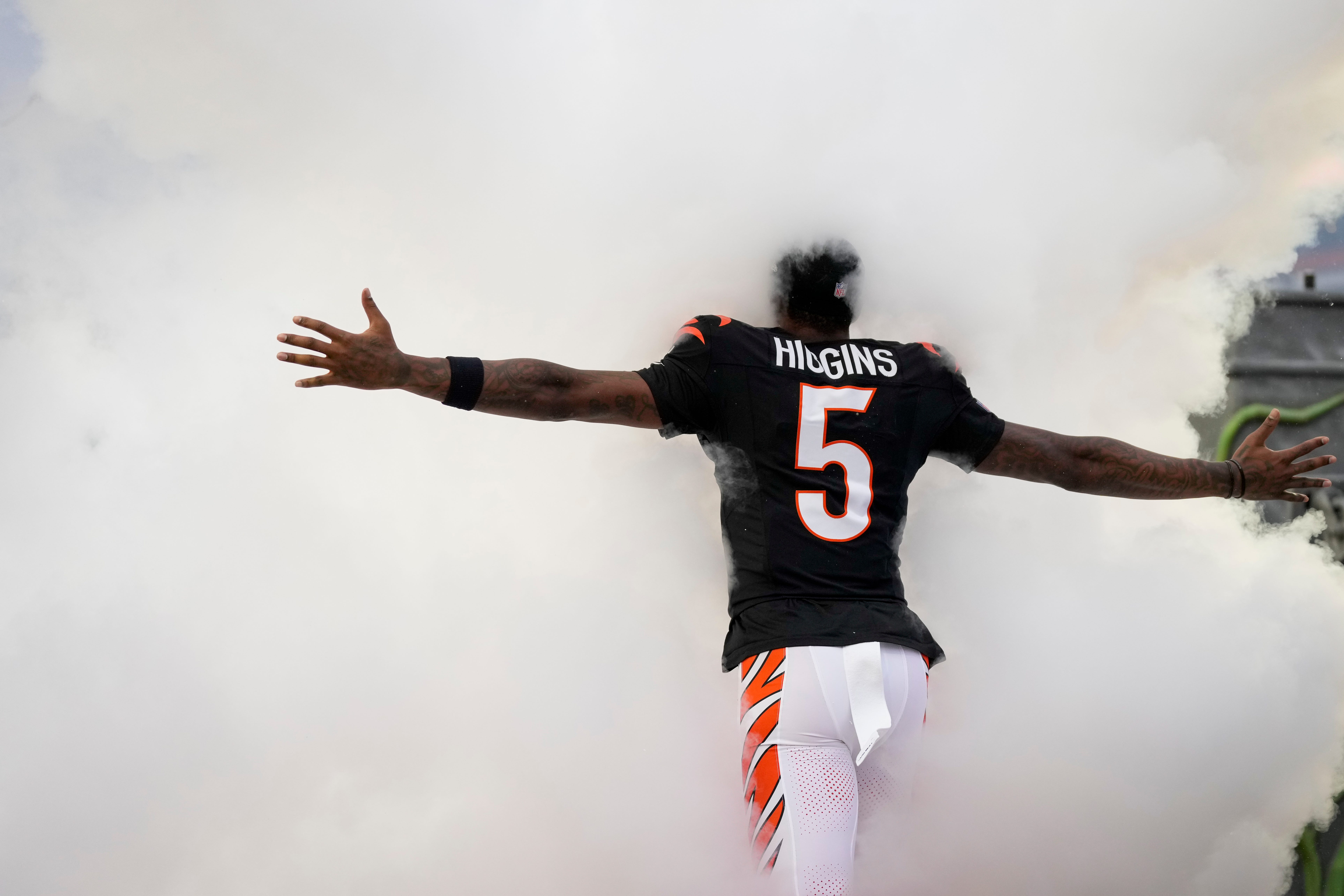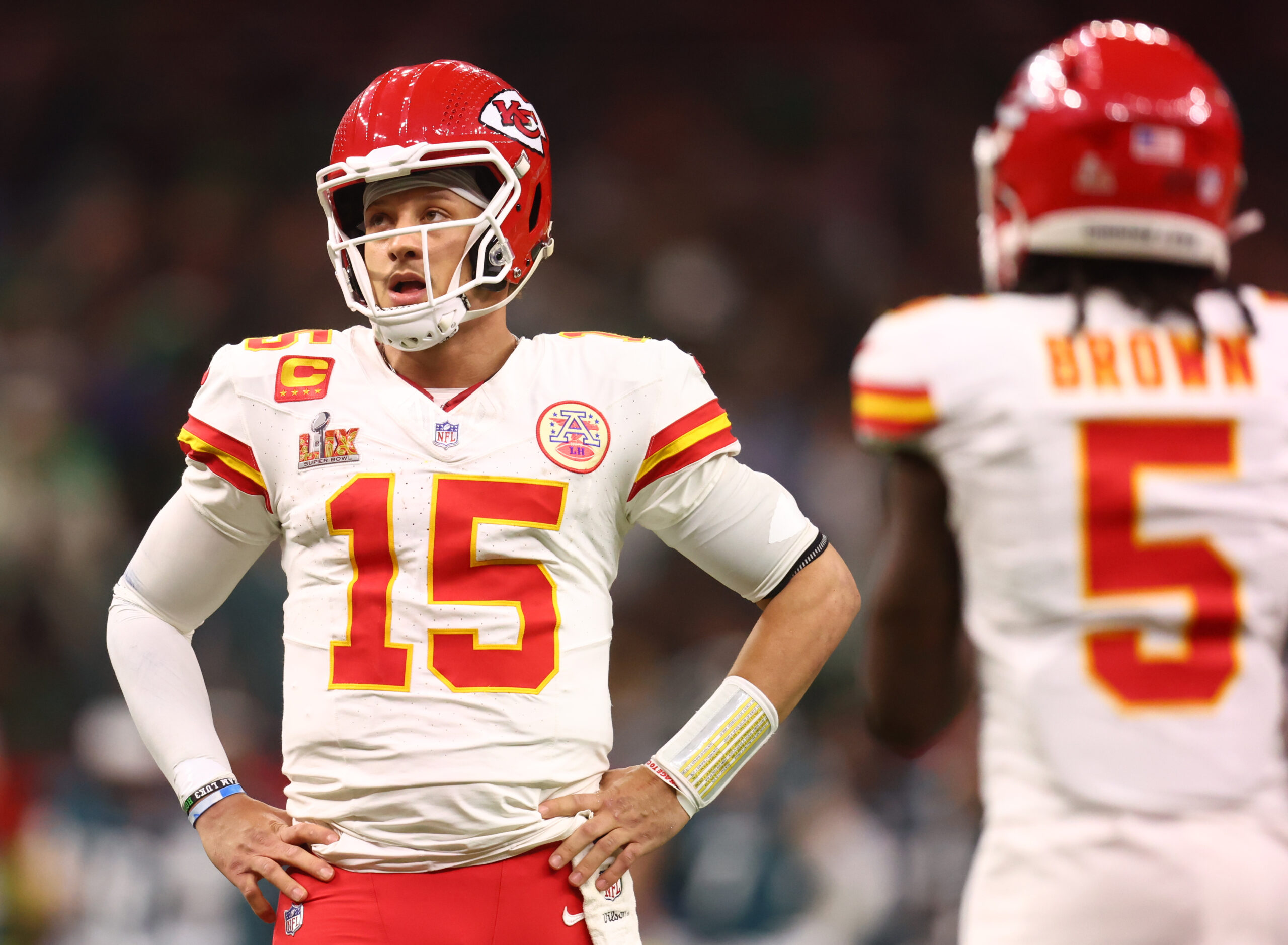NFL Analysis
2/10/25
18 min read
1st & 10: The Philadelphia Eagles Are Super Bowl Champions

No matter what your perspective was before the Philadelphia Eagles and Kansas City Chiefs kicked off at Super Bowl LIX, the overwhelming thought was the game was going to be close. The line was 1.5, suggesting a fairly even game. That is not how it played out.
The Eagles are Super Bowl champions for the second time in franchise history after a convincing 40-22 win against the Chiefs. We’ll get to how that happened on Sunday night, but first, we’ll start with how the foundation was laid before the season began.
Here’s the final 1st & 10 of the season for Super Bowl LIX.
All stats provided by TruMedia unless noted otherwise
1st & 10 Super Bowl LIX

1. How The Eagles Built A Super Bowl Team
Last season, the Eagles started the regular season 10-1 and looked like a front-runner for Super Bowl contention. Then, they won just one game for the rest of the year, including an embarrassing 32-9 loss to the Tampa Bay Buccaneers in the wild-card round.
In the offseason, Philadelphia made some massive changes. It started with the coaching staff. Offensive coordinator Brian Johnson was replaced by Kellen Moore, who had served just one season with the Los Angeles Chargers under Brandon Staley, who was fired before the season ended. More importantly, the combination of Matt Patricia and Sean Desai was replaced by Vic Fangio, who had an uneven season on and off the field in Miami.
Two coordinators who would not typically be available were swooped up and inserted to help turn around units that had tanked during the second half of the season. The Eagles went from fifth to 26th in offensive EPA per play and 26th to 30th. The vibes were bad.
Moore came in and modernized some of the offense. The Eagles used more motion, had better-designed passing concepts, and reliably had answers to beat the blitz.
Fangio, known for putting together great defenses but not historically known for flipping that switch immediately in Year 1, turned the Eagles into one of the best defenses in the league.
It was his best coaching job.
Vic Fangio Defensive Improvement In Year 1 Since 2000 (per TruMedia)
| Team | Year Before | Rank | Year 1 | Rank |
| 49ers | 0.04 | 11 | 0.11 | 2 |
| Bears | -0.08 | 29 | -0.03 | 24 |
| Broncos | 0.02 | 12 | 0.01 | 12 |
| Dolphins | -0.01 | 23 | 0.04 | 15 |
| Eagles | -0.05 | 30 | 0.09 | 2 |
It wasn’t just the coordinators. The offseason additions on the field came in the same vein — players with high upside but discounted for one reason or another.
After the running back market tanked during the 2023 season, Saquon Barkley was available for the cost of a free-agent No. 3 receiver. Mekhi Becton had struggled at left tackle and was moved inside to guard under the coaching of Jeff Stoutland. Zack Baun, a rotational edge rusher with the New Orleans Saints, signed a one-year, $3.5 million contract, was converted to an off-ball linebacker, and became an All-Pro.
The secondary, which was a weakness throughout the 2023 season, was revamped. Chauncey Gardner-Johnson was brought back after leaving on a one-year deal last year in free agency. In the draft, the Eagles doubled up at defensive back, selecting Quinyon Mitchell in the first round and Cooper DeJean in the second. Mitchell instantly became a potential No. 1 corner, and DeJean’s ability to play a version of the Star position opened up more possibilities for the Philadelphia defense.
These were additions to a roster that was already loaded with talent. First-round picks Jalen Carter, Nakobe Dean, and Jordan Davis came from a dominant Georgia defense and were developing into bigger roles. The same went for players like Milton Williams and Nolan Smith.
Perhaps the most revealing thing about how well this Eagles roster was built was that the player the team spent the most on in free agency — pass-rusher Bryce Huff with $34 million guaranteed — had 2.5 regular-season sacks and was inactive for the Super Bowl. Yet, the Philadelphia pass rush was still the biggest threat in the game.
This Eagles team was built for this moment.

2. A Runaway Half
When Kendrick Lamar got on stage, the game was essentially over, and not just for Drake. By the ESPN win probability model, the Eagles had a 97.5 percent chance of winning at halftime.
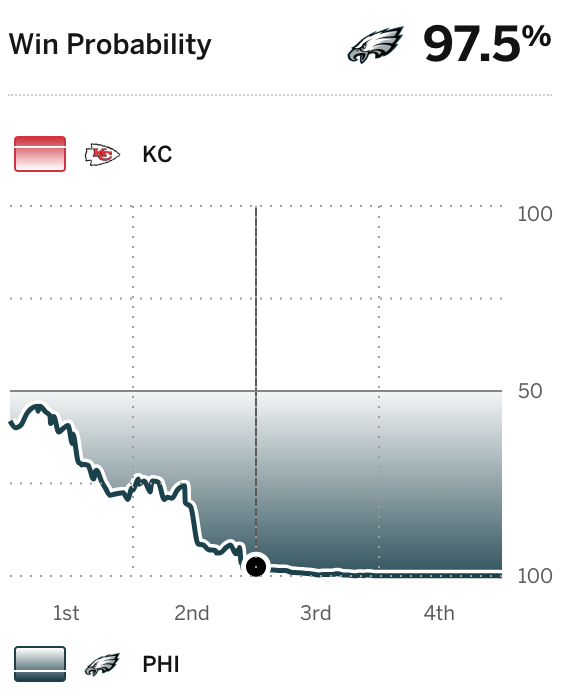
The Next Gen Stats model had the Eagles at 94 percent.

We’ve seen stranger things happen, especially in a Super Bowl, but the Eagles had put down one of the most lopsided beatings we’ve seen in the past decade. Super Bowl blowouts were common once upon a time, but as parity at the top has gotten closer, so too have the Super Bowl scores.
But when the Eagles took a 24-0 lead into halftime, it tied for the second-biggest differential at halftime with the San Fransico 49ers against the Denver Broncos at 24-3 in Super Bowl XXIV and just a point behind Washington’s 25-point lead against Denver, 35-10, in Super Bowl XXII, per Stathead.
In that first half, the Chiefs had just 23 yards and 1.1 yards per play. Not only had the Eagles shut the Chiefs down and limited the damage the offense could do, but Philadelphia had run almost double the number of Kansas City plays (39-20) and used the running game to keep control of the ball.
The Chiefs’ opening drive lasted four plays before a punt. That was their longest drive of the first half.

Late scoring drives by the Chiefs make the final score look closer than it was — the Chiefs actually finished the game with more yards per play than the Eagles after a 3.44-yard difference in favor of Philadelphia at halftime — but this game result was never in doubt.
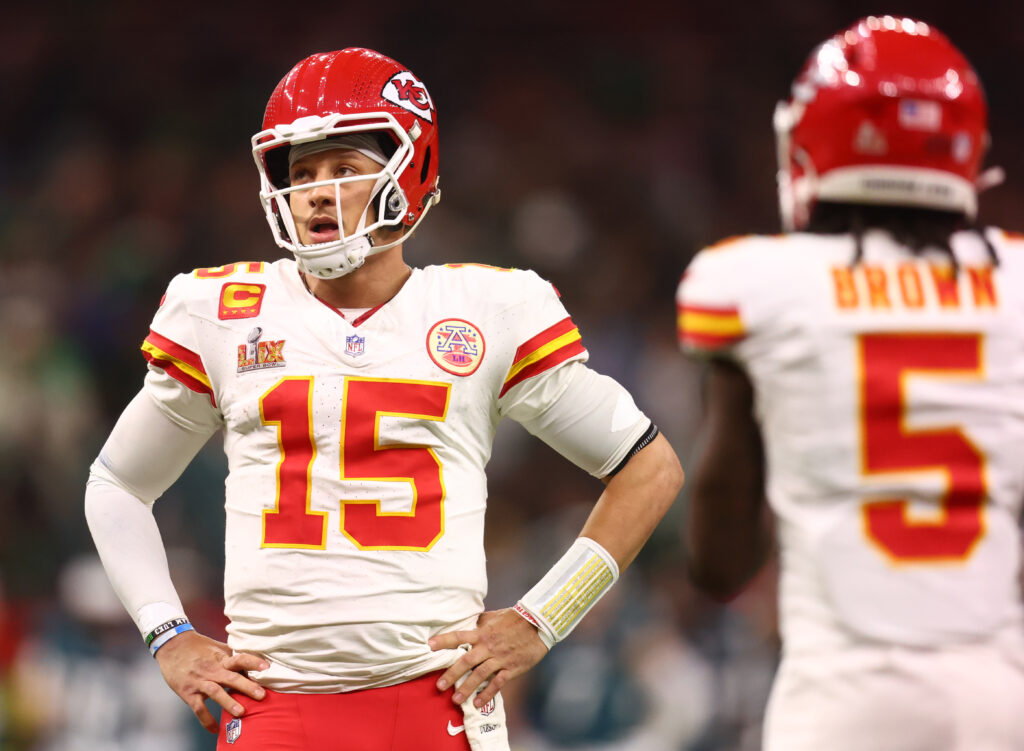
3. Holding Down Mahomes
In that first half, the Eagles held Patrick Mahomes to the worst first half of his career. Mahomes averaged -1.21 EPA per play in the first half, his previous career low being -0.73 during a regular season Week 7 game against the Tennessee Titans in 2021.
His 5.9 percent success rate was easily his lowest, trailing a 25 percent success rate from another 2021 regular season game in Week 9 against the Green Bay Packers. It’s also worth noting the next two games were in the AFC Championship Game loss against the Patriots following the 2018 season (27.3 percent) and in the Super Bowl loss to the Tampa Bay Buccaneers (29.2 percent).
Using a composite of EPA per play and success rate, this was easily the worst first half of Mahomes’s career.
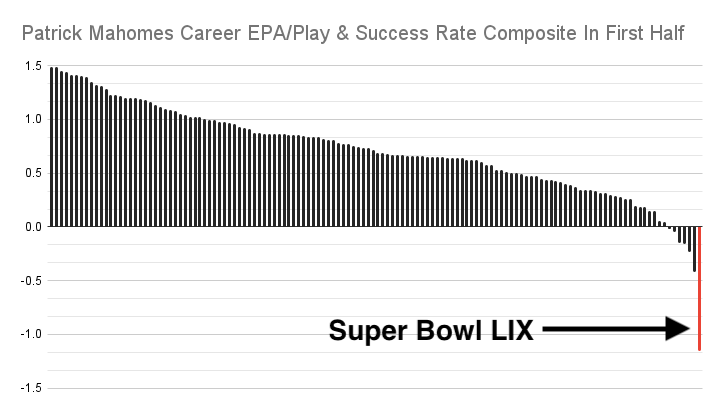
Overall, the game ended up as the fifth-worst game for Mahomes, according to success rate.
Worst Patrick Mahomes Success Rate In A Game (per TruMedia)

It was the fourth-worst by EPA per play.
Worst Patrick Mahomes EPA/Play In A Game (per TruMedia)
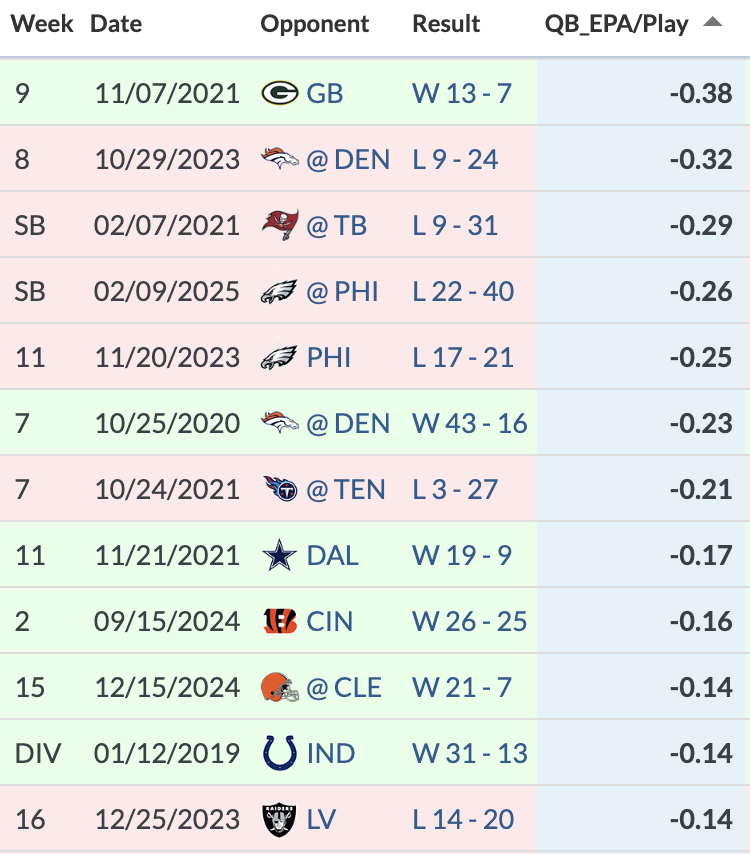
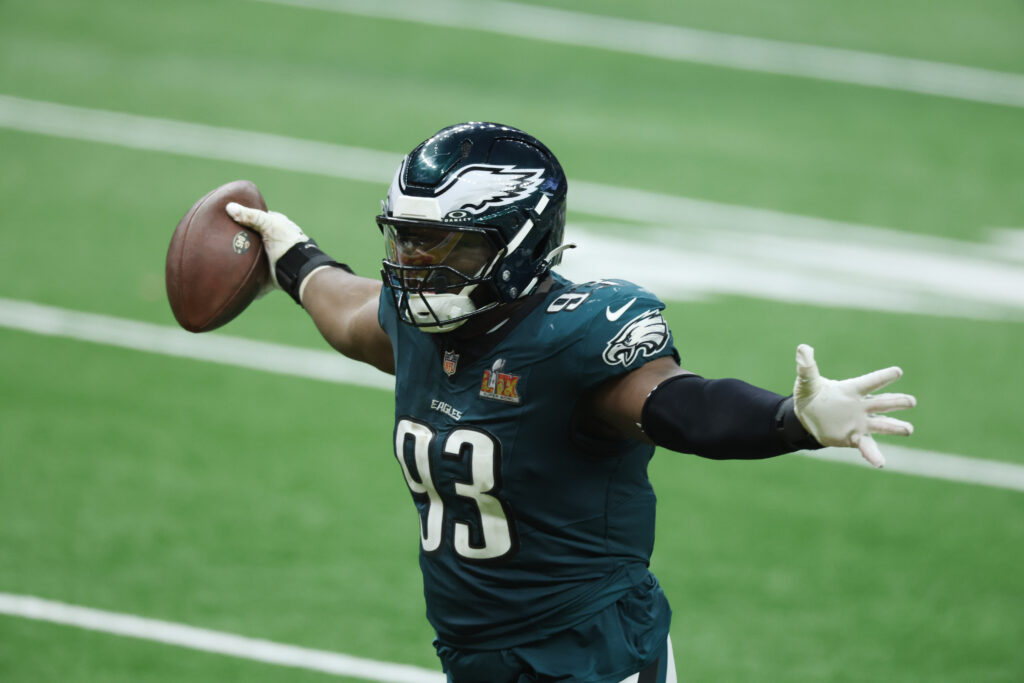
4. A Defensive Masterpiece
We focus on this side of the ball because even as the Chiefs limped through part of the season offensively, something would always open up for Mahomes, and he would find just enough to pull out a win. From the jump, it was clear that wasn’t going to happen.
There was nothing the Chiefs offense could do because the Eagles’ defense was all over everything. From the opening drive, Fangio had the Philadelphia defense attacking the quarterback, flowing to the ball, and sticking to receivers in coverage.
This was the ideal Fangio game. The Eagles played nickel on 98 percent of snaps and with a light box 91 percent of the time. Kansas City never presented the threat of the run — or getting bigger in personnel — and this played into how the Eagles wanted to structure the defense.
Kansas City opened up with some RPOs on its first drive, as the team did against the Bills in the AFC Championship Game, but never went back to it. After using bigger bodies to take advantage of defenses still playing nickel against their two tight end packages, the Chiefs stayed in 11 personnel on 73.5 percent of plays. It was 75 percent in the first half.
Fangio called a zone coverage on all but two dropbacks, according to Next Gen Stats. The Eagles played Cover-4 on 59.5 percent of plays, which was the third-highest rate by a defense since 2018.
With that Quarters shell over everything, Mahomes hesitated to pull the trigger when coverage was close. Despite it feeling like every Mahomes throw was covered, he technically only threw into a tight window on 10.7 percent of his attempts. Still, he had a -12.1 percent completion percentage over expected.
With so few easy, open throws, the Eagles got Mahomes to force some throws he typically wouldn’t. Rarely does Mahomes throw the ball to a lurking middle-of-the-field defender that he doesn’t see, but that happened twice.
On the Cooper DeJean pick-6, the Chiefs tried to flood the right side of the field, and Mahomes got out of the pocket to the right and tried to force a pass to Marquise Brown. DeJean was sitting on the right side of the field and moved back into the middle to jump in front of the pass. However, the coverage was so good that it looked like Quinyon Mitchell would have got in front of it, too.
— Dan's Clips (@dansfilmclips) February 10, 2025
Then, on the Zack Baun interception, Josh Sweat pushed Joe Thuney into the quarterback, and Baun dove to get in the throwing lane on a pass attempt to Brown.
The Quarters coverage helped take away many of the easy answers the Chiefs typically go to in the short area and the way Mahomes has played his best football by getting the ball out quickly. Instead, Mahomes was forced to hold onto the ball — an average of 2.99 seconds — and that allowed the pass rush to go to work.

5. Getting Pressure With Four
Philadelphia did not send a blitz against Mahomes and still pressured him on 42.9 percent of his dropbacks. The pressure came from everywhere, though the Eagles took advantage of the Chiefs' weaknesses along the offensive line. Knowing that the Eagles were likely going to rush four, the Chiefs sent five into a route on 81 percent of their dropbacks, but Kansas City could not hold up blocking Philadelphia’s front with just five blockers.
The Eagles sacked Mahomes six times, which was the most he’s been sacked in a game during his career. Philadelphia created pressure in multiple ways, too.
On the first sack, the Chiefs tried to chip Josh Sweat with Travis Kelce and have center Creed Humphrey pull over to help, but Sweat was so quick off the line that he got straight to the quarterback.
Then, on the next play, Sweat ran through an attempted double team with Kelce and Isiah Pacheco while Jalynx Hunt pushed Thuney back, and the two pass rushers met at Mahomes.
The Eagles ended up with 11 quarterback hits. Of the 10 times that Mahomes has been hit at least 10 times in a game, four were in the 2024 season. With so many issues along the offensive line, including Thuney staying outside at left tackle, the Eagles took advantage.
Sweat had a game-high eight pressures and 2.5 sacks. Milton Williams and Nolan Smith had four pressures.
While there were no blitzes, Philadelphia ran some stunts to create different looks and disrupt the Chiefs’ blocking.
On a third-and-9 sack in the second quarter, Williams rushed right against Thuney while Sweat worked through another Kelce chip attempt and bounced inside to take on guard Mike Caliendo, filling in at Thuney’s original spot.
Williams got Mahomes to leave the pocket and into Sweat. Mahomes tried to get away, but as Caliendo tried to recover from getting beat, the quarterback ran into his guard, and Williams caught Mahomes from behind for the sack.
Williams later pushed back Caliendo for a strip sack, and Jalen Carter hit Mahomes as the ball was knocked loose.
When pressured, Mahomes averaged -0.79 EPA per play with a 22.2 percent success rate.
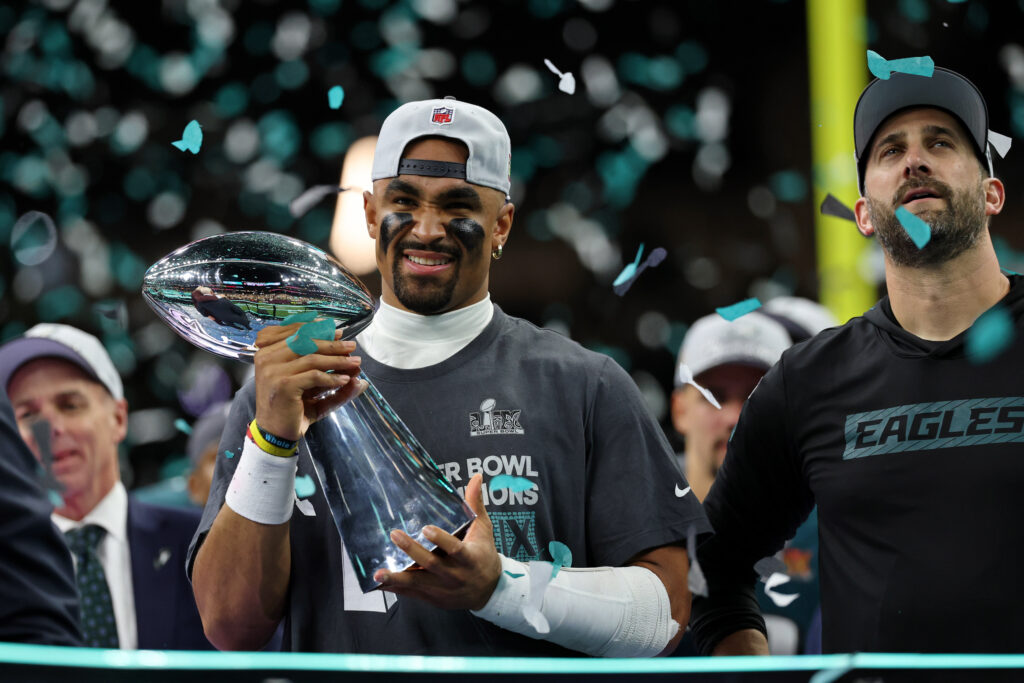
6. Jalen Hurts, Super Bowl MVP
I guess it’s finally time to get to the Super Bowl MVP, Jalen Hurts. Hurts was a deserved MVP because the Chiefs’ defensive plan was to make Hurts beat them — and he did.
Hurts averaged 0.39 EPA per play with a 57.1 percent success rate. It was one of the most efficient Super Bowl performances since 2000.
Best Super Bowl EPA Per Play Since 2000 (per TruMedia)
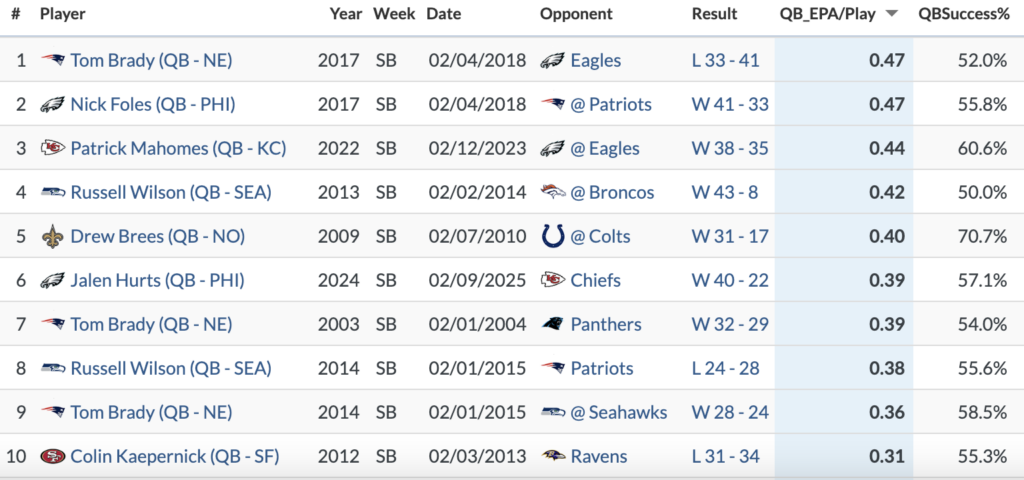
As the Eagles had a great game plan for the defense, they also did too on offense — letting Hurts play to his strengths with throws against 1-on-1 coverage on the outside and using his legs.
The first big play of the game came on a second-and-11 in the first quarter on a deep throw down the sideline to Jahan Dotson that set up the first Eagles touchdown. Kansas City was playing press on the outside, and Dotson pushed past Jaylen Watson and created a ton of separation down the field.
No team played press with both corners more than the Chiefs during the regular season. While the aggressive coverage typically worked, the corners were also prone to giving up big plays. Watson had allowed just a 42.9 percent completion rate when playing press — a -12.2 percent CPOE per Next Gen Stats — but he still allowed 1.4 yards per coverage snap while allowing two plays of 20 or more yards.
Watson was also beat off press on the DeVonta Smith kill-shot touchdown late in the third quarter.
The Eagles picked on that 1-on-1 outside coverage, including a back-shoulder throw to A.J. Brown on a scoring drive in the second quarter.
Hurts threw 77.3 percent of his passes outside the numbers. He was 8-of-10 for 81 yards for 0.43 EPA per play on those throws.
Philadelphia was also ready to take advantage of Kansas City's zone coverage, getting Brown open on a crosser, which Nick Bolton chased for a 12-yard touchdown.
— Dan's Clips (@dansfilmclips) February 10, 2025
In a game where the defensive game plan was intended to mess with Hurts, he never felt out of control. An early interception to Bryan Cook on an underthrown ball could have been a tipping point earlier in the season, but the Eagles bounced right back for a field goal on the following drive. By the time Hurts got the ball back again, Philadelphia was up 17-0 after the DeJean pick-6.
Hurts used his legs well in this game, with most of his damage done as a scrambler. He had a 17.2 percent scramble rate and averaged 0.73 EPA per play, with a 60 percent success rate on those plays. He ended the game with 11 carries for 72 yards and a touchdown.
This caps off Hurts playing two of his best games of the season in the NFC Championship Game and the Super Bowl. His 0.40 combined EPA per play in those two rounds was the fourth-best since 2000, behind Nick Foles (0.57), Matt Ryan (0.53), and Kurt Warner (0.41).
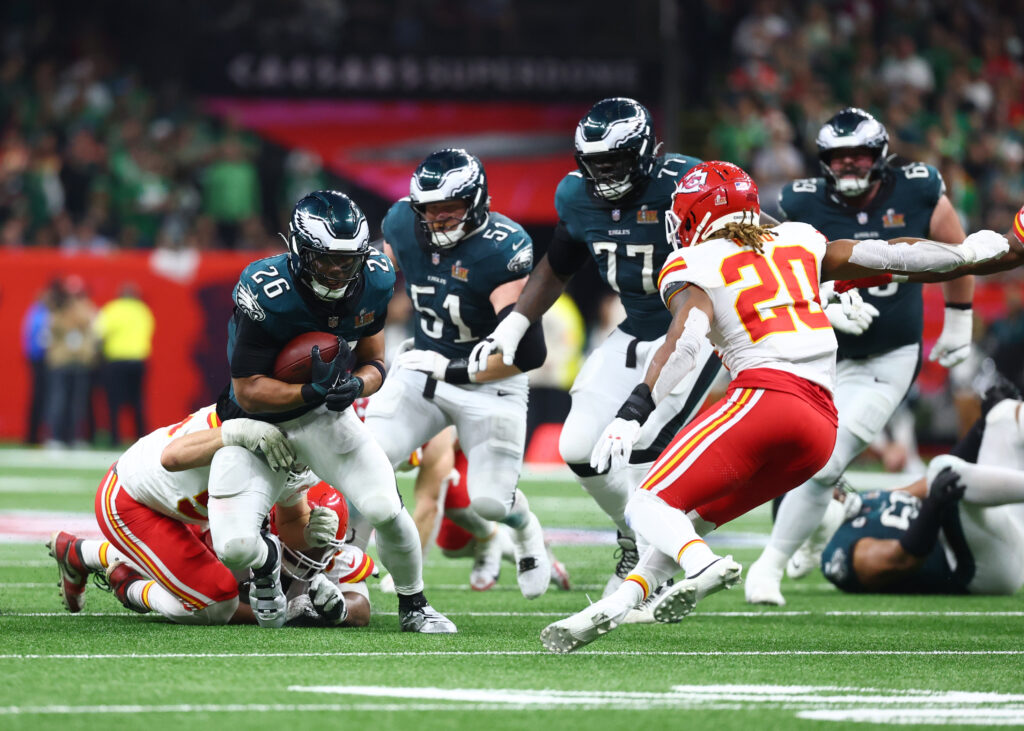
7. The run game didn’t work, and it didn’t matter
If anyone had been told that Barkley would be held to 57 yards on 25 carries with a long of 10 yards, nearly 100 percent of people would have assumed a comfortable Kansas City win.
Barkley's success rate was 16 percent, his lowest of the season with the Eagles. He averaged just 0.80 yards before contact per rush, his third-lowest rate for a game this season, with the other two coming against the Steelers (0.37) and Browns (0.33).
The Chiefs had bodies around the line of scrimmage but played with a neutral seven-man box on 50 percent of Barkley’s runs in the first half. Kansas City created some penetration along the front but also had linebackers flowing quickly to the run, rarely allowing anything to develop on the second level.
While the boxes weren’t stacked, making sure there would be defenders in the middle of the field to fit the run kept those 1-on-1 matchups outside for the passing game. Barkley never broke one, but he never needed to for the offense to function.
He not only helped set up big plays by grabbing the attention of the defense — look at how the Eagles were able to attack the defense on the DeVonta Smith touchdown because of how the Chiefs were forced to condense into the middle of the field…

…but Barkley was also an integral piece of the pass-blocking and continued to pick up blitzes with ease.
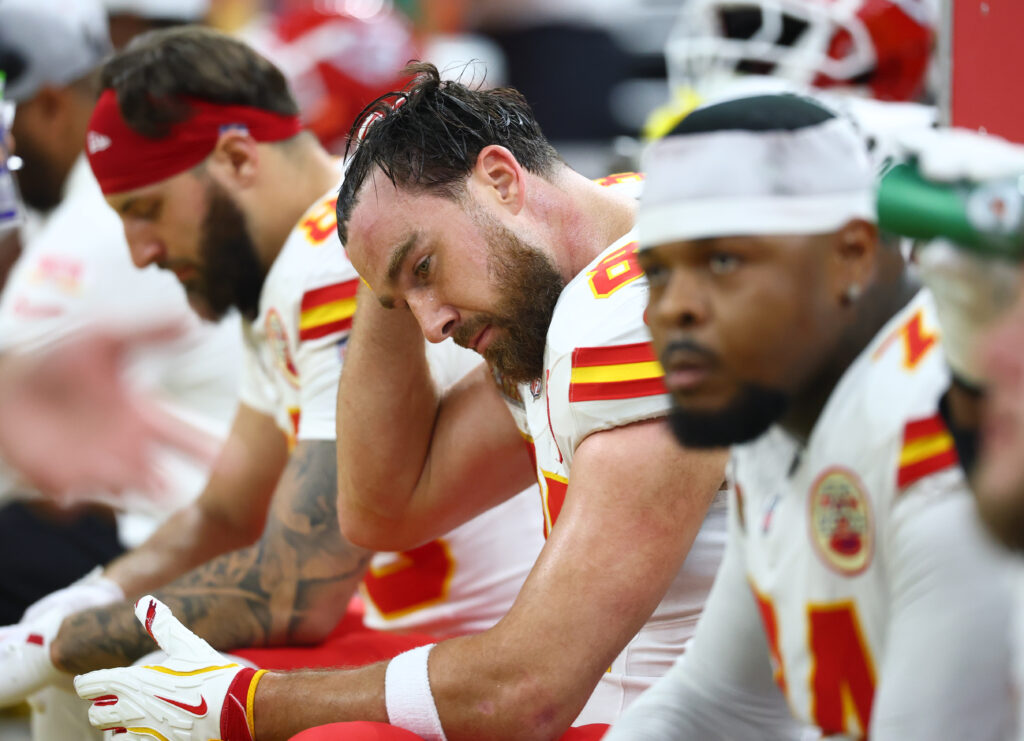
8. Where do the Chiefs go from here?
The last time the Chiefs were embarrassed in a Super Bowl, they fortified the offensive line and rebuilt the offense around smarter and shorter passes. Kansas City once again needs to upgrade the offensive line — though guard Trey Smith is set to be a free agent — but the explosive element of the passing game needs to return.
Getting back Rashee Rice could help. His presence in the short area was missed all season, and having him take on those routes could have opened things up down the field for players like Xavier Worthy, who had to shift to a lower aDOT role as the season progressed. Worthy's deep touchdown in the fourth quarter by running between two deep defenders could be a sign of things to come.
Getting back to an attacking offense should be the top priority for this team. Mahomes can cover up so many things for this offense — as he did for most of the season — but making him play perfectly in high-leverage situations leaves a small margin for error and depletes some of his talent that could be used more optimally if a downfield passing attack was more readily available. We thought that might be his evolution this season — maybe it will be next year.
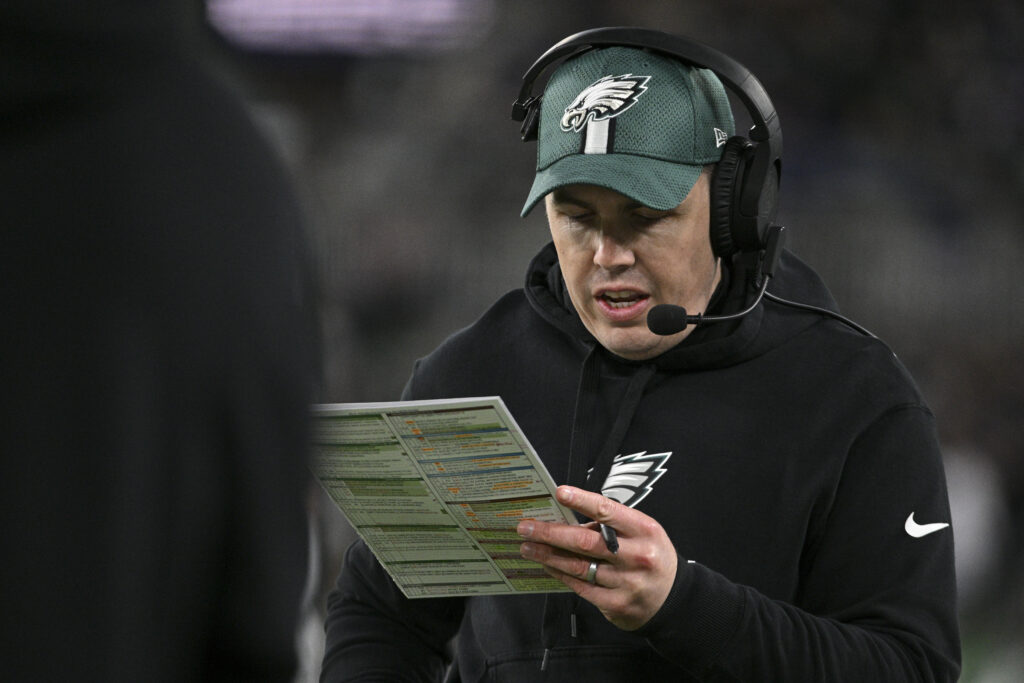
9. Can The Eagles Keep Getting Better?
The Eagles are going to lose players like Sweat and Williams in free agency, but this is a team that consistently replenishes at positions of need, even before they’re needed.
Philadelphia has $18 million of cap space entering the offseason. There are a few ways to open up more, such as converting some option bonuses into signing bonuses to continue to push prorated figures into future years.
What’s amazing is this Eagles team is still one of the youngest in the league — the eighth-youngest overall and the fifth-youngest defense in the regular season — per snap-weighted age.
So much of this core is going to stay in place. The Eagles appear to need to figure out what to do on offense next season, with Kellen Moore the reported choice to be the next head coach of the New Orleans Saints. With a better idea of what worked this season, they’ll go into that in a position of strength rather than trying to fix what went wrong as they did last offseason.
Of course, the Eagles are never going to sit back and be content, so there’s undoubtedly some big move on the horizon that will make observers wonder why the other 31 teams didn’t do it.
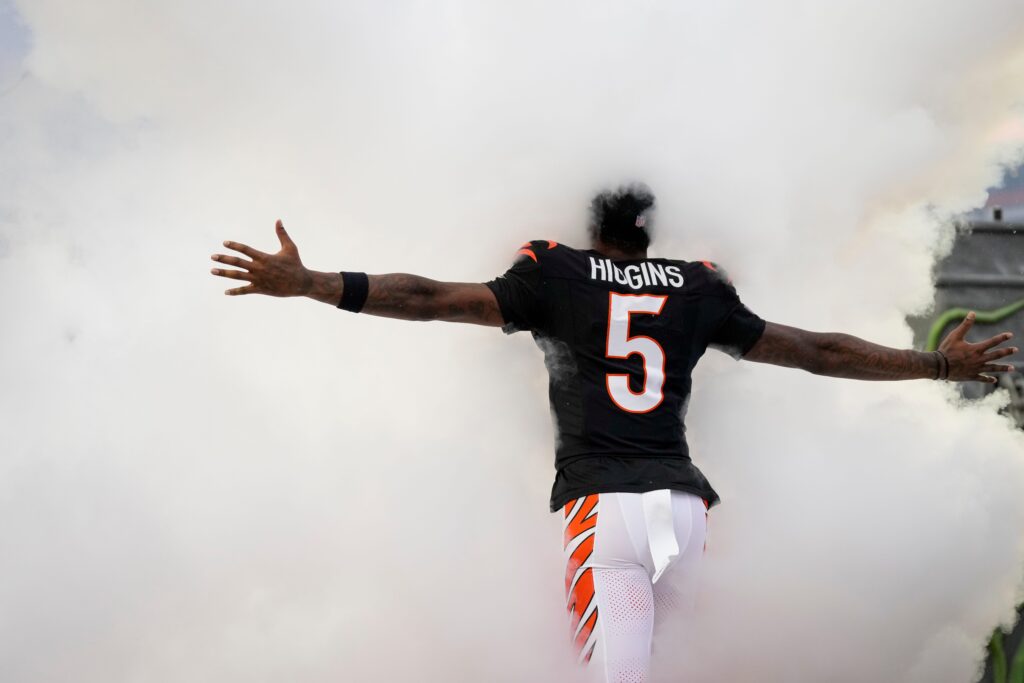
10. We’re not done yet
Thanks to everyone for reading this column all season. It was a joy to put together, even as I wrapped this one at 2:30 am (the earliest this column has been completed all year).
But just because the Super Bowl is over doesn’t mean we’re not jumping directly into what’s next. This site is already loaded with great draft coverage — the NFL Combine is just a few weeks away — and we’ve already posted my top 100 free agent rankings.
It’s been a fun season. Thanks for coming along, but don’t go anywhere.



